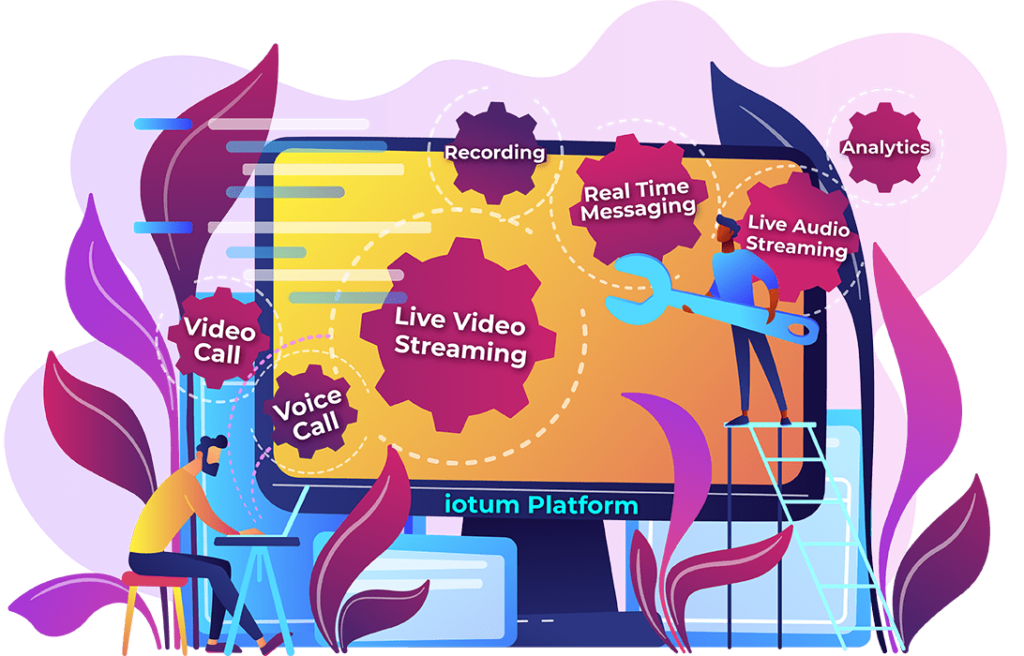 A company’s strength, growth, and overall health are determined by the workforce that generates its momentum. The power is in the people therefore a rock-solid Human Resources team is paramount to the successful operations of a business – especially since video conferencing is changing the remote-work game.
A company’s strength, growth, and overall health are determined by the workforce that generates its momentum. The power is in the people therefore a rock-solid Human Resources team is paramount to the successful operations of a business – especially since video conferencing is changing the remote-work game.
The HR department’s job is to scout for employee potential, recruit top talent; develop, retain and support employees as well as be a mouthpiece for the company by keeping everyone informed of structural and business-wide changes.
With web conferencing solutions in place to harmonize the office ecosystem, HR professionals can defy space, time, and location by speaking to anyone, anywhere. Whether you have some experience with video communications or you’re just getting your feet wet, read on for some tips and tricks for any HR role run more smoothly.
Overall, video conferencing:
- Promotes remote work
- Forges collaboration
- Gives way to better engagement
- Saves company money and time
- Saves employee money and time
- Improves productivity
- Helps grow small businesses
So how does this positively affect HR professionals?
8 Benefits Of Video Conferencing For HR Professionals
- An Exponentially Bigger Talent Pool
Remote work is aplenty, and the traditional business model is being bent to accommodate it. If the best person for the sales position doesn’t live in the country, with a video conferencing communication strategy, it doesn’t really matter. Hire the talent you need from anywhere instead of having to choose locally. - Simplified Internal Communication

Use video conferencing software to create short and concise webinars if employees are experiencing a block or if you need to disseminate corporate communications on the fly. Also, emails are important, but instant messaging and text chat provided during a video call is just as effective – and it can be recorded for later use.
- The Best Employees Have A Better Chance At Staying
Online communication needs to be fast, easy, collaborative and accessible. Transparency is key. Utilizing collaborative systems that unite workers, reinvigorate corporate culture and spike productivity by streamlining support, project management and more create a positive online working environment that nurtures not only a good output of work but also camaraderie, forging a more “whole” experience for workers to feel fulfilled. - Travel Costs Are Significantly Reduced
Save company money when it comes to meeting a new or potential hire in person. Employee travel, hiring packages, hotels, cars, and per diems can all be significantly reduced with video conferencing software that offers an instant face-to-face meeting without the extra frills. - Overall Increased Efficiency
Discuss projects faster and cut down on long email threads. Sometimes a quick demonstration can be easier than typing out paragraphs. Use presentations and screen sharing to show instead of tell and get everyone on the same page in half the time. - Screen Sharing For The Win
If a candidate has a portfolio or needs to share a presentation as part of the hiring process, it’s pretty simple to walk through it online. With screen sharing, the candidate can click to share and walk you through their presentation viewed on their screen. Consider how this can be viewed in a huddle room, projected on a large screen for a massive audience or viewed on a mobile device! It’s the second best thing to viewing it in real life as though the candidate were standing right there. - Consistency Between Office And Online
Video conferencing using screen sharing works to push forward a sense of consistency and urgency. In a video chat, the material is shared in real time and worked on in real time, which means it’s automatically updated and stored in the cloud. Files can’t just suddenly disappear or be deleted, and the file itself is worked on instead of trying to sort through old versions. - Strengthened Relationships
It’s as simple as showing your face using your camera during a video call. Seeing a person’s body language, their face and mannerisms prove to be very valuable. This is how we learn about a person and build better working relationships – or nab a job!
Optimizing Video Conferencing For HR Professionals
Video conferencing offers HR unparalleled communication to not only workers and talent overseas or outside of the office, but also just down the hall. Implementing video calls and conferencing across the many functions of HR streamlines tasks such as hiring, onboarding, training and retaining potential hires.
How To Hire New Talent
The beauty of using a two-way group communication platform to meet and hire employees is that you are put in front of each other face to face. Plus, you can hire based on actual talent and experience rather than finding the best you can in your local vicinity. Also, even though you’re hiring for skills, video conferencing helps to break through and reveal personality, giving HR professionals a better sense of who is a team player and who would be a cultural fit – two key points when hiring long-term.
- Strengthen Your Online Brand
Local talent will most likely know your brand and what you stand for. Talent overseas, however, may not be so familiar. If you want your organization to attract potential hires from different talent pools all over the globe, ensure your brand is very forward facing. You’ll want to portray yourselves as innovative, trustworthy and credible. What do your social media accounts look like? When was the last time you updated the website? - Make Online Applications A Breeze
To ensure the smoothest experience, make it really easy for candidates to apply. Third-party job search websites are helpful but double-check your messaging is consistent across different channels. Pro-tip: Comb through applications in search of buzzwords like “independent,” “excellent communication,” “good time management,” and others if you want effective remote workers who can hold their own. - Use Video Conferencing For Interviews
Once you’ve found a promising individual, it’s easy to move the process along with interviews done online:- You can have an initial, generalized video conferencing interview with a candidate to get a sense of who they are and how they operate. Open up about the role, their responsibilities, and past experience.
- If this phase goes well, set up a secondary interview with the candidate’s potential team and key leaders. Make sure everyone’s video is on and hit record if a decision-maker can’t make it.
- If the candidate makes it through this round, shoot out an offer letter and schedule a third video chat to discuss benefits, salary, accommodation, scheduling, etc.
How To Bring On New Talent
Onboarding usually requires paperwork, meeting and greeting, asking and answering questions, and generally establishing ground zero with a new hire. Set then up for success right from the get-go with video conferencing technology that streamlines communication and work.
- Online Meetings With IT
Whether physically in the office or working from home, chances are communication with IT will be frequent. Set up new hires for success by providing the digital tools and technology required to hit the ground running. Do they require access to the company’s network and software or are they expected to provide their own? Will they use online sharing software like Google Docs? What login info is required? Do they need a VPN? What apps do they need to download for messaging, authentication, project management, etc? - Online Meetings With HR
Once a new hire is sympatico with the tech and company network, coordinate a video call to address any outlying concerns. If there is paperwork, for example, you can offer pointers or address questions. You can also check in to see how they’re settling in! - Online Meetings With Team
Schedule an introductory video conference with the new hire’s team, particularly their line managers and higher-ups within their first week. This is especially important and will set the tone. It’s recommended that teams meet face to face, but if there’s a long time in between video calls, at least the introductory video chat will provide a solid base and allow the new hire to put a face to the name.
How To Train Remote Talent
- Lead With Expectations
Establish clear expectations of how the new hire is to communicate, work, and be productive. Align with what works for them and for the greater good of the company. This can be best achieved over a video call. -

Provide Personalized Training
Remote workers and freelancers generally operate according to when they can find the time to work at their own pace (especially if there is a time difference). Bring them up to speed with how your business runs by giving them access to short webinars (made using video conferencing software) that further breaks down company culture, processes, systems, etc. Online slideshows, documents, presentations and more will also work to get them oriented. - Check-In Frequently
New hires will always ask questions. Training is ongoing and constantly needed to stay updated and ahead of the trend. Encourage a regular loop of feedback so new hires can stay on top of their workload.
A Few More Video Conferencing Pro-Tips:
- Appearance Is Everything
With the transition from office to online, it’s not surprising that people may not be aware of the appropriate dress code or where to set up. In light of the current pandemic, most companies have loosened up their business attire to be more accommodating for remote workers. If, however, you are making a first impression with people outside your company, it’s suggested you look polished. In a survey done in the UK, 1 in 6 workers admit to only being partially clothed while taking a video call. That means, no work out gear, t-shirts or messy hair – at least from the waist up! - Fight The Urge To Turn Off The Webcam
It’s critical to keep the webcam on and engage in video calls as this is the way you will actually get to know someone and vice versa. Being the face of the organization establishes camaraderie and trust. - Schedule “Catch Up” Chats
Inspire remote workers to open a little about their personal lives. It doesn’t haven’t to be full-on, but try briefly discussing the past weekend, asking about hobbies or inviting a pet to appear on screen. This breaks the ice and segues nicely into work chat and since these conversations organically happen in the office, why not online? - Not Speaking? Hit Mute
Video conferencing etiquette 101: Background noises, feedback or accidentally overheard conversations take away from the task at hand. Muting yourself when you’re not talking ensures a pleasant online meeting for everyone involved. - Provide Necessary Info
Use the Invites and Reminders option to include login info or special instructions ahead of time. Or include the info in an email or in a chat. Doing it in advance helps to avoid headaches and technical snafus!
Let Calbridge cater to your needs as an HR professional. With state-of-the-art software that integrates seamlessly with project management and live streaming tools, plus comes loaded with features and offers peace of mind with high-end security, you can perform at your best. Use the screen sharing feature, and high definition audio and video to make your company look polished when facing potential hires.


